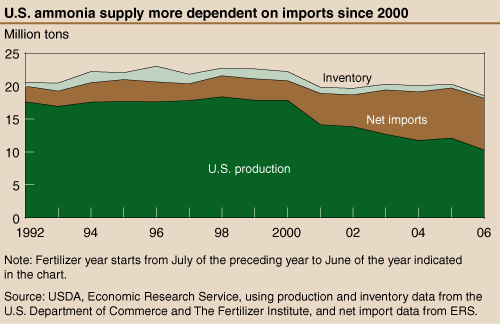Tight Supply and Strong Demand May Raise U.S. Fertilizer Prices
- by Wen-yuan Huang
- 11/1/2007
Nitrogen accounted for 56.6 percent ofthe 21.3 million tons of chemical fertilizernutrients (nitrogen, phosphate, andpotash) used by U.S. agriculture in 2006.The composite fertilizer price increased 113percent between 2000 and 2007, led bygains in nitrogen prices. During this 7-yearperiod, the price of ammonia, the mainsource of nitrogen in fertilizer production,increased 130 percent from $227 to $523per ton. The price of urea, the primary solidnitrogen fertilizer used in the U.S., rose 127percent from $200 to $453 per ton.
Increased nitrogen prices affect allcrop producers, but especially corn andwheat growers, for whom nitrogen costsare the largest single operating expense.Nitrogen applications accounted for 18percent of the operating costs for corn producersand about 30 percent for wheatproducers. Total nitrogen costs for U.S.corn production were $2.98 billion in 2005and $0.9 billion for wheat in 2004.
Corn accounted for the largest shareof nitrogen use among all crops. Plantedacres of corn were relatively unchangedfrom 2000 through 2006, but jumped 19percent from 78 million acres in 2006 to93 million acres in 2007. Expanded plantingof corn acres is due to high corn prices,driven by growing ethanol demand and strong export sales. Farmers are expectedto apply an additional 1 million nutrienttons of nitrogen to the 2007 corn crop.Furthermore, increasing world demand fornitrogen is expected to continue in thenear term. Overall, global nitrogendemand grew 14 percent from 2000 to2006. Greater nitrogen demand from othercountries could make U.S. imports ofnitrogen fertilizers more costly.
At the same time, the U.S. supply ofammonia for nitrogen fertilizers has beendeclining. Because natural gas is the primaryraw material used to produce ammonia,the volatile and upward trend in U.S. natural gas prices led to a 35-percentdecline in U.S. ammonia production capacityand a 44-percent decrease in outputbetween 2000 and 2006. Meanwhile, U.S.ammonia imports increased 115 percent.The share of U.S.-produced ammonia inthe U.S. aggregate supply dropped from 80to 55 percent, while the import shareincreased from 15 to 42 percent. Theannual U.S. aggregate ammonia supplydeclined 17 percent, while the inventorylevel dropped 71 percent.
Further expansion of ethanol productionand continued strong export sales ofcorn could boost U.S. demand for nitrogenfertilizers. Further increases in natural gasprices may limit U.S. production capacityto produce ammonia. The additional supplyof nitrogen needed to meet theincreasing demand may have to comefrom imports and thus make U.S. crop producersmore vulnerable to changes in globalnitrogen and natural gas markets.
This article is drawn from:
- Huang, W. (2007). Impact of Rising Natural Gas Prices on U.S. Ammonia Supply. U.S. Department of Agriculture, Economic Research Service. WRS-0702.
You may also like:
- Fertilizer Use and Price. (n.d.). U.S. Department of Agriculture, Economic Research Service.
- Fertilizer Imports/Exports. (n.d.). U.S. Department of Agriculture, Economic Research Service.


